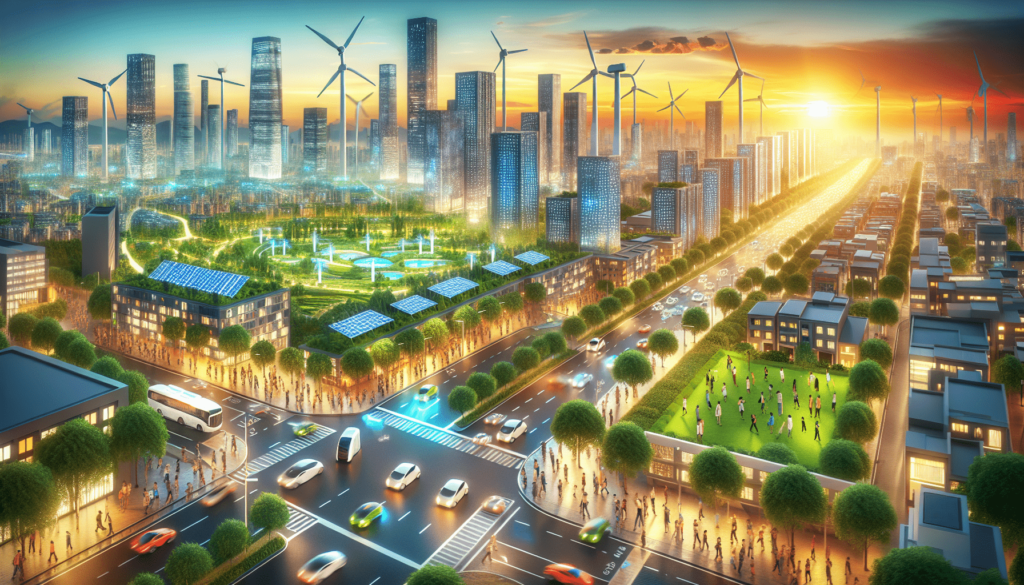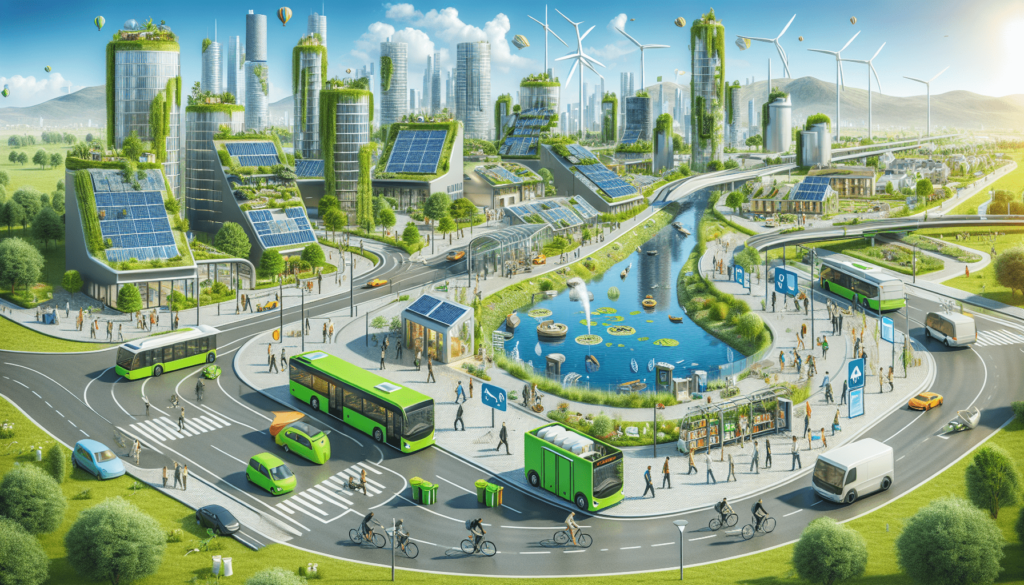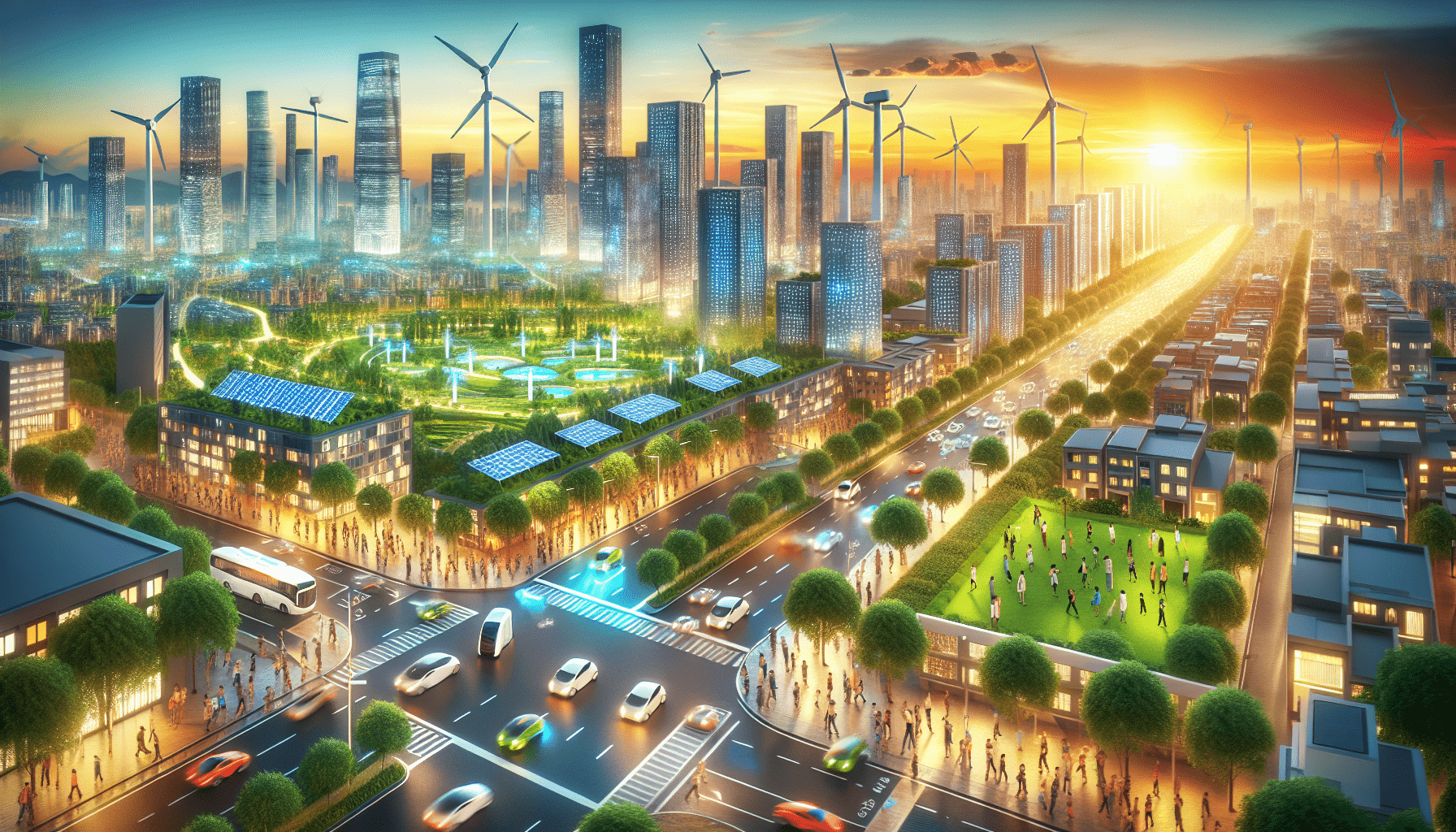You’re about to embark on an exciting journey into the future of sustainable urban development. In this captivating article, you will discover how cities are transforming themselves into eco-friendly havens, embracing innovative technologies, and adopting sustainable practices to ensure a brighter tomorrow. Get ready to explore the possibilities and find out how these changes can positively impact our lives and the environment. Get ready to envision a future of cleaner, greener, and more vibrant cities.
Introduction
Welcome to the future of sustainable urban development! In this article, we will explore the various aspects that contribute to creating environmentally friendly and livable cities. By implementing smart infrastructure, promoting sustainable transportation, preserving green spaces and biodiversity, embracing the circular economy, building climate resilience, engaging communities, harnessing renewable energy, embracing digital innovation, and implementing effective policies and governance, cities can pave the way for a brighter and greener future.
Smart Infrastructure
Implementation of smart technologies
In the quest for sustainable urban development, the adoption of smart technologies plays a crucial role. These technologies leverage data and connectivity to optimize the efficiency of urban systems. Smart sensors and real-time data enable cities to monitor and manage energy consumption, traffic flow, waste management, and more. By analyzing this data, cities can make informed decisions to improve resource allocation and reduce their environmental impact.
Energy-efficient buildings
Energy-efficient buildings are a cornerstone of sustainable urban development. With innovative technologies like smart lighting, advanced insulation, and energy management systems, buildings can significantly reduce their carbon footprint. Green building certifications, such as LEED (Leadership in Energy and Environmental Design), promote the construction of energy-efficient structures. Additionally, retrofitting existing buildings with energy-saving features contributes to a more sustainable urban landscape.
Smart grid systems
The implementation of smart grid systems is essential for sustainable urban development. These systems integrate renewable energy sources, such as solar and wind power, into the electricity grid. By combining clean energy generation, energy storage solutions, and real-time monitoring, cities can ensure a reliable and sustainable power supply. Smart grids also enable energy distribution optimization, promoting energy efficiency and reducing costs.

Sustainable Transportation
Promotion of public transportation
To achieve sustainable urban development, cities must prioritize public transportation. By investing in efficient and well-connected public transit systems, cities can reduce private car usage and traffic congestion. Integrated multimodal transportation networks, featuring buses, trains, trams, and subways, encourage people to choose sustainable mobility options. Alongside affordable and accessible public transportation, convenient infrastructure like bike-sharing and pedestrian-friendly streets enhance sustainable urban mobility.
Investment in electric vehicles
Electric vehicles (EVs) are an integral part of sustainable transportation. Investing in EV infrastructure, such as charging stations, is paramount. Incentives for EV adoption, like financial incentives and free parking for EVs, encourage people to switch to cleaner transportation alternatives. The widespread adoption of electric buses and taxis also contributes to reducing air pollution and greenhouse gas emissions significantly.
Bicycle-friendly infrastructure
Creating bicycle-friendly infrastructure is crucial for sustainable urban development. Dedicated bike lanes, bike-sharing programs, and secure bike parking facilities incentivize cycling as a viable mode of transportation. These initiatives reduce traffic congestion, improve air quality, and promote a healthier lifestyle. Furthermore, integrating bicycles into public transportation systems enhances the overall connectivity and accessibility of a city.
Green Spaces and Biodiversity
Urban parks and gardens
Green spaces, such as urban parks and gardens, are essential components of sustainable urban development. These areas provide recreational spaces for residents, support biodiversity, and improve air quality. City planners must prioritize the creation and preservation of parks, ensuring that they are accessible to all residents. Well-designed parks with walking paths, playgrounds, and greenery create a sense of community and contribute to the overall well-being of urban dwellers.
Roof gardens and vertical farming
Utilizing rooftops for gardens and vertical farming is an innovative approach to sustainable urban development. Green roofs help cool buildings, improve stormwater management, and add natural beauty to the urban landscape. Vertical farming brings agriculture closer to urban centers, reducing transportation distances and carbon emissions associated with food production. By capitalizing on unused spaces, cities can enhance food security, promote local produce, and improve the overall environmental performance of the built environment.
Conservation of natural habitats
Preserving and restoring natural habitats within cities is vital for sustainable urban development. Urban areas should include protected green spaces that support native flora and fauna. Strategies like rewilding, which involves reintroducing native species and restoring ecological processes, contribute to biodiversity conservation. Efforts to connect these green spaces through ecological corridors allow wildlife to move freely and ensure the long-term sustainability of urban ecosystems.

Circular Economy
Waste reduction and recycling
Implementing a circular economy approach is crucial for sustainable urban development. Cities must focus on waste reduction through recycling, composting, and waste-to-energy solutions. Educating residents about waste management practices, providing recycling infrastructure, and encouraging responsible consumption habits play a vital role. By minimizing waste generation and maximizing resource recovery, cities can reduce landfill usage and promote the sustainable use of materials.
Resource-efficient manufacturing
Promoting resource-efficient manufacturing processes is another pillar of a circular economy. By adopting sustainable practices like eco-design, lean manufacturing, and closed-loop production, cities can decrease resource consumption and minimize environmental impact. Encouraging businesses to prioritize sustainable supply chains and embrace green technologies contributes to the long-term viability of urban industries.
Sharing economy platforms
Sharing economy platforms foster sustainable urban development by maximizing the use of existing resources. Platforms for sharing vehicles, tools, and household items reduce individual ownership and encourage collaborative consumption. By increasing resource utilization and reducing waste, sharing economy initiatives contribute to a more sustainable and equitable urban society.
Climate Resilience
Adaptation strategies for extreme weather events
As climate change intensifies, cities must prioritize climate resilience. Implementing adaptation strategies for extreme weather events, such as hurricanes and floods, is essential. Green infrastructure solutions like urban forests, permeable pavements, and green roofs support stormwater management, mitigate the urban heat island effect, and enhance overall climate resilience. By incorporating climate considerations in urban planning, cities can safeguard their communities against the impacts of climate change.
Efficient water management
Effective water management is crucial for sustainable urban development. Cities must prioritize water conservation and promote efficient water use practices. Implementing rainwater harvesting systems, water reuse initiatives, and smart irrigation technologies helps reduce water demand and minimize strain on freshwater resources. Additionally, improving wastewater treatment systems ensures that water resources are preserved and protected.
Green infrastructure for flood control
Green infrastructure solutions are essential for flood control in sustainable urban development. Constructing rain gardens, bioswales, and wetland systems helps manage stormwater runoff, prevent flooding, and support biodiversity. These nature-based solutions provide multiple benefits, including improved water quality, reduced flood risks, and enhanced overall ecological resilience. Integrating green infrastructure into urban design enhances the aesthetic appeal of cities while promoting sustainability.
Community Engagement
Building sustainable communities
Community engagement is a fundamental aspect of sustainable urban development. Cities should encourage citizen involvement in decision-making processes, empowering residents to shape the future of their neighborhoods. Engaging communities in sustainable initiatives fosters a sense of ownership, promotes social cohesion, and ensures that development plans align with local needs and aspirations. By creating opportunities for collaboration, cities can build sustainable communities that thrive.
Participatory urban planning
Participatory urban planning is a powerful tool for sustainable urban development. Involving residents in the planning and design of their neighborhoods leads to more inclusive and livable cities. By organizing workshops, town hall meetings, and online platforms for public input, cities can gather diverse perspectives and ideas. This participatory approach ensures that urban development is transparent, equitable, and sustainable.
Local empowerment and education
Empowering and educating local communities is crucial for sustainable urban development. Promoting sustainability literacy and providing training in green technologies equips residents with the necessary knowledge and skills to contribute to a more sustainable future. Educational programs, awareness campaigns, and community-led initiatives foster a culture of sustainability and enable individuals to make informed choices for themselves and their communities.
Renewable Energy
Solar power integration
Integrating solar power into the energy mix is essential for sustainable urban development. Cities can install solar panels on rooftops, public buildings, and open spaces to generate clean energy. In addition to reducing greenhouse gas emissions, solar power contributes to energy diversification and enhances the resilience of urban energy systems. Net-metering policies and incentives encourage residents and businesses to adopt solar energy, ensuring a sustainable and decentralized energy future.
Wind energy projects
Harnessing wind energy is another pathway to sustainable urban development. Cities located in windy regions can establish wind farms to generate renewable electricity. Wind turbines integrated into the urban landscape or situated offshore contribute to the local energy mix and reduce reliance on fossil fuels. By investing in wind energy projects, cities can reduce carbon emissions and promote sustainable energy generation.
Geothermal and hydropower systems
Using geothermal and hydropower systems for energy generation contributes to the sustainability of urban areas. Geothermal energy harnesses the Earth’s heat, providing a reliable and renewable energy source. Cities can tap into geothermal reservoirs for heating and cooling purposes, reducing reliance on fossil fuels. Additionally, hydropower systems utilize the energy of flowing water to generate electricity, further diversifying the urban energy portfolio and promoting sustainability.
Digital Innovation
Internet of Things (IoT) in urban development
Digital innovation, particularly the Internet of Things (IoT), revolutionizes sustainable urban development. IoT devices, embedded in urban infrastructure, enable real-time monitoring and optimization of various systems. Smart lighting, waste management, and transportation systems, powered by IoT, enhance energy efficiency, reduce waste, and improve urban livability. By utilizing IoT technologies, cities can create intelligent and interconnected urban environments.
Big data analytics for urban planning
The analysis of big data plays a crucial role in sustainable urban development. By aggregating and analyzing vast amounts of data, cities can gain insights into urban trends and make data-driven decisions. Big data analytics can inform urban planning, transportation optimization, energy management, and environmental conservation efforts. With real-time data, cities can respond efficiently to challenges and continuously improve their sustainability strategies.
Digital platforms for citizen engagement
Digital platforms facilitate citizen engagement and strengthen the connection between residents and local governance. Online platforms enable residents to voice their opinions, report issues, and participate in decision-making processes. From crowd-sourcing ideas for urban projects to providing feedback on policies, digital platforms enhance transparency and inclusivity in sustainable urban development. By leveraging digital technologies, cities can create a more participatory and responsive urban governance framework.
Policy and Governance
Supportive regulatory frameworks
Supportive regulatory frameworks are vital for successful sustainable urban development. Governments must enact policies that incentivize sustainable practices and penalize environmentally harmful activities. Regulations for energy efficiency, waste management, and transportation are crucial to encourage sustainable behavior. Legislative measures can also promote sustainable building practices, renewable energy adoption, and green transportation alternatives. By providing clear guidelines and creating a level playing field, supportive policies drive sustainable change.
Collaborative governance models
Collaborative governance models foster sustainable urban development by facilitating partnerships between governments, businesses, and civil society. Engaging stakeholders in decision-making processes, such as public-private partnerships and multi-stakeholder platforms, leads to a more inclusive and holistic approach to urban development. Collaboration between different sectors ensures that diverse perspectives are considered, and innovative solutions are developed. By breaking down silos and promoting cooperation, collaborative governance models drive sustainable urban transformation.
Incentives for sustainable urban development
Providing incentives for sustainable urban development is crucial to encourage widespread adoption of sustainable practices. Financial incentives, such as tax breaks for green building certifications, subsidies for renewable energy projects, and grants for energy-efficient retrofits, motivate businesses and individuals to invest in sustainability. Governments can also develop reward programs for sustainable practices, such as waste reduction and recycling initiatives. By offering tangible rewards, cities stimulate sustainable behavior and accelerate the transition to a greener future.
In conclusion, the future of sustainable urban development lies in the integration of smart infrastructure, promotion of sustainable transportation, preservation of green spaces and biodiversity, adoption of circular economy practices, building climate resilience, engaging communities, harnessing renewable energy, embracing digital innovation, and enforcing effective policies and governance. By embracing these fundamental pillars, cities can create livable, eco-friendly, and inclusive urban environments for generations to come.

